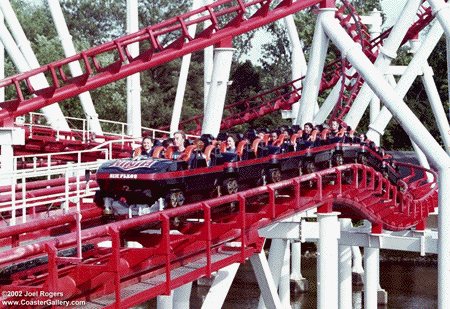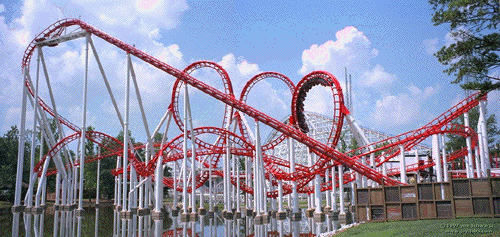


Before you ride:
*Use triangulation to determine the height (h1) of the first hill and the height (h2) of the largest loop.
1 = ____________ degrees (hill)
2 = ____________ degrees (hill)
1 = ___________ degrees (loop)
2 = ___________ degrees (loop)
h1 = __________________ meters
h2 = __________________ meters
Step back and look carefully at the loop. It is not really circular. For safety's sake, the car is going faster than the absolute minimum speed at the top of the loop - so even when friction is a factor, this additional speed would make the rider uncomfortable at the bottom of the loop if it were truly circular. This high acceleration, high force at the bottom of the loop is avioded by using what is called a clothoid loop in place of a circular loop. Sketch the loop as you see it. The raduis of curvature is changing. Does this increase or decrease as you go from the bottom to the top of the loop?

While you ride:
Use your vertical accelerometer to measure the g's at various points during the ride.
Maximum acceleration ___________ g's experienced at the (bottom, midway, top) of the loop.
Minimum acceleration ___________ g's experienced at the (bottom, midway, top) of the loop.
QUESTIONS AND CALCULATIONS:
1. What happens to the gravitational potential energy on your way down the first hill?
2.Describe (in detail) the transition between gravitational potential energy and kinetic energy as the coaster goes through a loop.
3. What two forces are acting on the train at the top of the loop? Give the direction of each force.
4. Why doesn't the rider fall out of the train at the top of the loop and land on his head?
5. Using the data colected above, calculate the value of the gravitational potential energy at the top of the highest hill and at the top of the loop.
6. From conservation of energy considerations use the change in height from the top of the first hill to the top of the loop to calculate the speed of the train as it goes through the highest point in the loop. Does this satisfy the critical speed criteria? Vc = (rg)
7. Assume that the loop is circular. From your measure of the height - calculate the critical velocity and the kinetic energy at the top of the loop.
8. From the potential energy calculated in #1 and from the kinetic energy calculated in #2, calculate the velocity of the train at the top of the loop. does the train have enough speed to travel in a circle?
9. What force would be exerted on you at the bottom of the loop if the loop were circular? How many g's would this be? Since most people begin to feel uncomfortable beyond 3.5 g's and some even pass out just over 4 g's, do you see why a clothoid rather than a circular loop is used?
ANY OTHER OBSERVATIONS OR QUESTIONS?